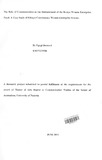| dc.description.abstract | This study sought to establish the role communication played in the disbursement of Kenya Women Enterprise Fund. Kikuyu Constituency Women Enterprise Scheme was used as the case study. The study investigated whether there is in place a communication strategy for implementing the fund, how communication is impacting on the fund's performance and what informs communication decisions and activities for those charged with administering the fund.
The study specifically set to determine the communication strategies employed by Community Development Assistants (CDAs), how these influence attainment of the fund's goals and also determine women groups' communication behavior. The researcher, through non-probability sampling, selected all the locational CDAs in charge of the six locations of the constituency as research subjects. The basis of their selection was the role they play as the link between women and women groups and Constituency Women Enterprise Scheme (C - WES) management at the constituency level.
Through probability sampling, sixty women groups were selected from all the six locations. Women group leaders were considered as representative of their groups and therefore used as research subjects. The researcher used questionnaires to collect data.
The study identified the roles of communication in the disbursement of C - WES in Kikuyu as: information dissemination, awareness creation, attitude formation, knowledge creation and women mobilization. Other roles include education, persuasion, raising
aspirations and feeding interpersonal channels.
,
The study established communication from other sources and not from the CDAs influenced group decision to or not to apply for C - WES loans. CDAs have not put in place a communication strategy for C - WES implementation. The study established the mobile telephone and face - to - face as the mam communication channels used by women groups among themselves. Other channels
include letters and notes as well as member home visits.
CDAs rely mainly on interpersonal communication. Their communication is, however, irregular as it is dependent on the regularity of women group members' visits to the CDAs' offices. The researcher also established communication between the CDAs and women groups is mainly linear vertical top - bottom with rare provision for feedback from women groups. As a result of poor communication between the two, information women groups have is not only inadequate but also in some instances misleading. This has led to low loan applications and group registration and apathy among women groups.
Several suggestions were made on how to improve communication regarding C - WES and its management. They include: introducing women representation in C - WES management, regular meetings with the CDA, provision of women group feedback channels and timely communication from CDAs. Others are: non - selective information dissemination by CDAs as well as follow - up and feedback from their offices. The study also established women groups are not involved in C - WES management. CDAs' involvement does not go beyond group registration, awareness creation and issuance and scrutinizing of application forms.
The study recommended bringing on board other C - WES stakeholders in the fund's management. Communication should be given consideration alongside other concerns for the fund such as its coverage. C - WES management should put in place communication strategies for marketing the fund. To this end the study recommended training of CDAs in Development Communication. They should be facilitated to reach the women for more effective communication and interaction. Regarding the C - WES, the study recommended devolving its management to locations under women group committees to streamline communication. Specialists should train
the women on various aspects of group activities such as management and value addition.
This would create need to seek additional funding beyond conventional group savings. Regarding future research, the study recommended investigation into the actual C - WES beneficiaries and how their lives have been transformed. The study also recommended a model for effective use of communication for grassroots involvement in community development. | en_US |

